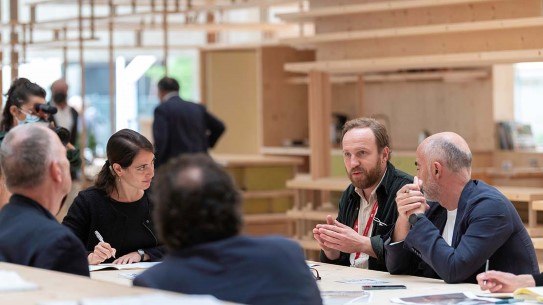Cohousing. Bringing it to Italy! Learning from Norway

The discussion of the exhibit What We Share continues. Italian architects, researchers and developers gathered in The Nordic Pavilion Saturday 25 September to learn from the exhibition and the new cohousing wave of Norway. One of the topics discussed was how the Italians may develop their own models for cohousing.
Hosting the seminar was the Torino based think-tank Homers. With the backdrop of the exhibition What We Share. A Model for Cohousing as a backdrop the participants discussed what Italy can learn from the Nordic model for cohousing, and what to implement in new Italian cohousing projects. At the table were developers, architects and researchers from the Torino, Milan and Venice schools of architecture.
"In Italy we start to hear about cohousing about fifteen years ago, when the Politecnico of Milan disseminated the results of a research, carried out together with a private real estate development agency, to investigate the housing situation in the city of Milan, and the citizens’ level of knowledge and interest in cohousing." writes Silvia Cafora of Homers.
"Now we want to open a comparison with Norwegian cohousing making to understand the characteristics of the phenomenon in the Nordic countries, in particular in Norway, and to identify the possible replicable elements, useful for the creation of an Italian market."
Cafora opened with the assertion that supply and demand does not correlate. A survey showed that 98 percent of the participants are interested in learning about the phenomenon of cohousing, but only 0,003 percent of Italians lives in shared housing.
Curator of The National Museum, Martin Braathen, talked about why cohousing were chosen as a theme for the exhibition in The Nordic Pavilion. Siv Helen Stangeland from Helen & Hard Architects presented ongoing projects and experience from developing cohousing. One of Stangelands key messages was that Italy has a different and more social culture than the Nordic countries. The Italians are used to a richer street life, other family structures and a different climate – do they really need a model for cohousing?, was her polemic question.
The provocation was picked up by the participants who argued that cohousing has grat potential in Italy. Ezio Micelli from IUAV said the interest for more sustainable forms of living is in demand among younger italians. However, the Nordic model needs some adjustments to suit the Italian market. It must find new ways for financing, and other shared functions. For example, sharing one big kitchen is not something the Italians would be interested in, said Matteo Robiglio of Homers.
One of the similarities with Norway is Italy’s large share of self-owned housing – 80 percent of housing are self-owned. Transforming existing buildings and abandoned industrial property may give valuable access to property, said Simone Sfriso from Venetian architects TAM Associati.
Other contributors were Raul Pantaleo from TAM Associati, Ezio Micelli fra IUAV, Andrea Mariotto og Andrea Curtoni.